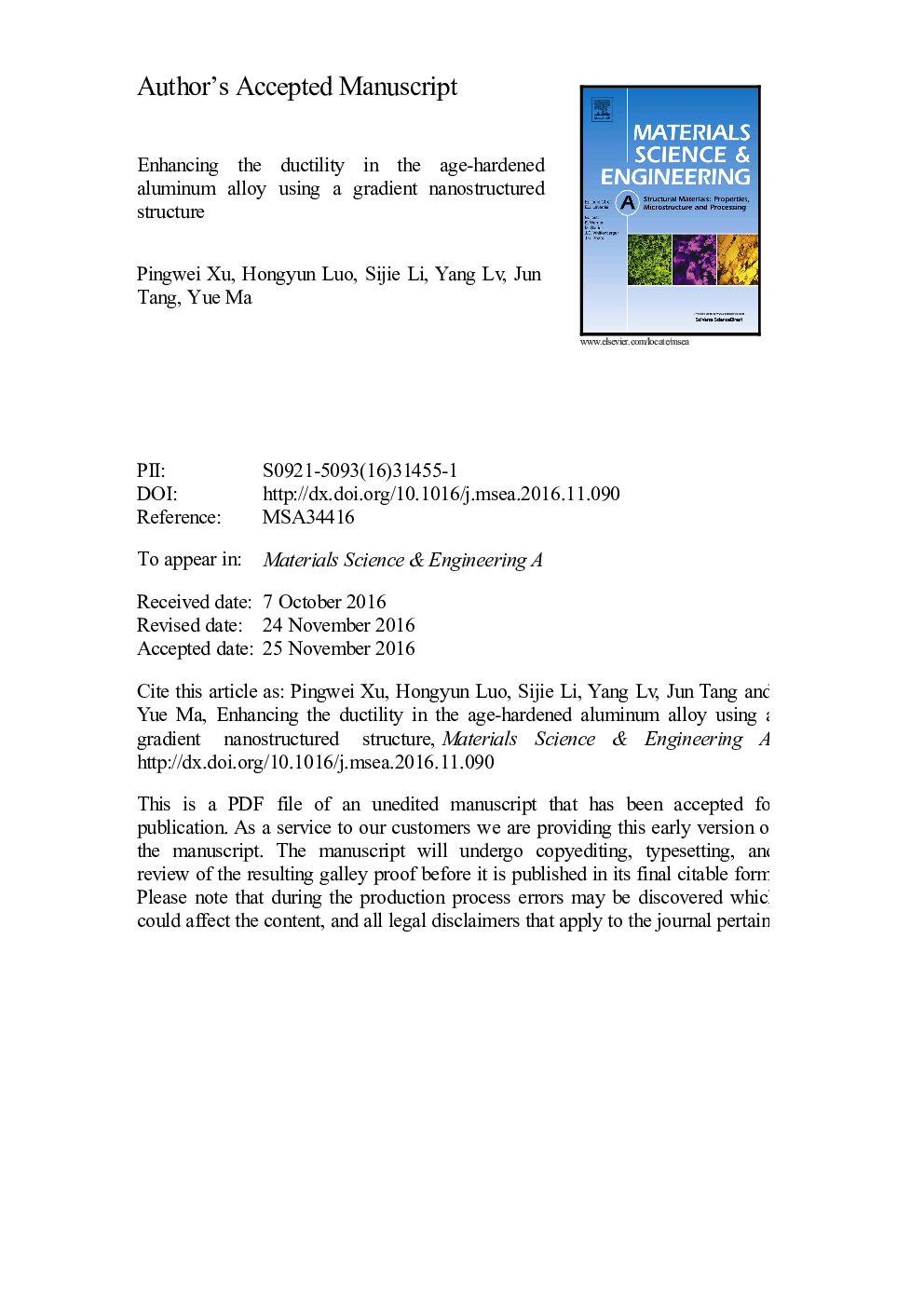| کد مقاله | کد نشریه | سال انتشار | مقاله انگلیسی | نسخه تمام متن |
|---|---|---|---|---|
| 5456449 | 1514661 | 2017 | 36 صفحه PDF | دانلود رایگان |
عنوان انگلیسی مقاله ISI
Enhancing the ductility in the age-hardened aluminum alloy using a gradient nanostructured structure
ترجمه فارسی عنوان
افزایش انعطاف پذیری در آلیاژ آلومینیوم سخت شده با استفاده از یک ساختار نانوساختار گرادیان
دانلود مقاله + سفارش ترجمه
دانلود مقاله ISI انگلیسی
رایگان برای ایرانیان
کلمات کلیدی
مواد نانوساختار، شکل پذیری، ساختار گرادیان، استرس باقی مانده، آلیاژهای آلومینیوم،
ترجمه چکیده
ورق نازک و سخت افزاری اضافی در آلیاژ آلومینیوم سخت سخت شده، اما بدون بهبود قدرت از طریق معرفی یک لایه نانوساختار گرادیان به دست می آید. شیب فشار و تنش های باقی مانده مختلف بین لایه گرادیان و ماتریکس عمدتا مسئول ارتقاء ورق است، در حالی که ظهور ضعف های اقلیتی (رسوب مرز دانه) برای تغییر قدرت به حساب می آید. استرس باقی مانده فشاری باعث خنثی شدن و انتشار می شود و همکاری مکانیزم جابجایی جزئی در لایه گرادیان را فعال می کند. همراه با استرس باقی مانده کششی از ماتریس، شیب فشار بیشتر در طول تست کشش افزایش می یابد. علاوه بر این، نمونه هایی با لایه گرادیان ضریب تاثیر قابل توجهی بر خواص کششی دارند، که به دلیل تنش باقی مانده فشاری است که در معرض ضعف است. سهم متفاوتی از مکانیسم های تقویت و معایب اختلاف معنی داری بین فلز خالص و آلیاژ با لایه گرادیان ایجاد می کند. این کار درک جدیدی از مواد شیب دار را فراهم می کند که برای کاربرد واقعی برای مواد پیچیده واقعی ضروری است.
موضوعات مرتبط
مهندسی و علوم پایه
مهندسی مواد
دانش مواد (عمومی)
چکیده انگلیسی
A high ductility and extra strain hardening are achieved in the age-hardened Al alloy but without strength improvement via the introduction of a gradient nanostructured layer. The strain gradient and different residual stress between gradient layer and matrix are mainly responsible for the enhanced ductility, while the appearance of minority flaws (grain boundary precipitations) accounts for strength change. Compressive residual stress suppresses crack nucleation and propagation and cooperatively activates the partial dislocation mechanism in gradient layer. Combined with tensile residual stress from matrix, strain gradient is further increased during tensile testing. Besides, samples with the gradient layer exhibit significant thickness effect on the tensile properties, due to varying compressive residual stress occurring at flaws. Different contributions from strengthening mechanisms and flaws make the significant difference between pure metal and alloy with a gradient layer. This work provides new understanding of gradient materials, which is imperative to practical application for real complex materials.
ناشر
Database: Elsevier - ScienceDirect (ساینس دایرکت)
Journal: Materials Science and Engineering: A - Volume 682, 13 January 2017, Pages 704-713
Journal: Materials Science and Engineering: A - Volume 682, 13 January 2017, Pages 704-713
نویسندگان
Pingwei Xu, Hongyun Luo, Sijie Li, Yang Lv, Jun Tang, Yue Ma,
